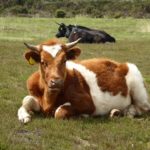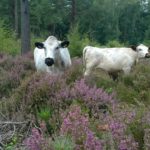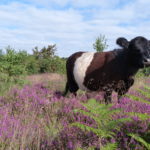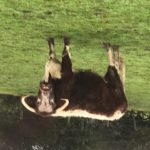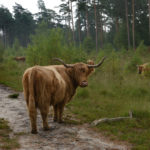Spotlight: Why grazing can be amazing for conservation
May 6, 2020
Livestock are a common sight in the South Downs, but what role do they play in the eco-system? Katy Sherman is an activities and engagement officer for Heathlands Reunited, a National Lottery Heritage-funded project working to save our heaths, and delves deeper into the importance of grazing. She also reveals what types of livestock you might see on heaths!
Across the National Park there are livestock of all different shapes, sizes and breeds grazing on a variety of different landscapes. To ensure that wildlife habitats are managed for the greatest environmental benefit, the type, number and timing of livestock grazing is tailored to the needs of each individual site.
Different types of livestock graze in different ways and this influences their suitability for grazing individual habitats, such as farmland, chalk grassland and heathland. Even within livestock types individual breeds can graze differently. So this is why you will see a mixture of horses, cows, sheep, and goats in the South Downs National Park.
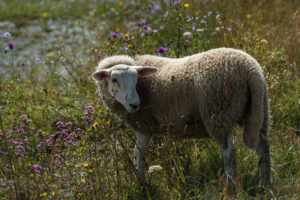 Conservation grazing plays a key role in maintaining rare habitats like heathland by controlling aggressive species which would otherwise dominate areas through scrub encroachment. In the past, the countryside would have been grazed by wild animals or through traditional farming and common land grazing practices. Many landowners seek to replicate these kinds of grazing systems to maintain and increase biodiversity. Livestock grazing removes plant material more gradually than cutting or burning and is a very natural and sustainable way to manage a landscape.
Conservation grazing plays a key role in maintaining rare habitats like heathland by controlling aggressive species which would otherwise dominate areas through scrub encroachment. In the past, the countryside would have been grazed by wild animals or through traditional farming and common land grazing practices. Many landowners seek to replicate these kinds of grazing systems to maintain and increase biodiversity. Livestock grazing removes plant material more gradually than cutting or burning and is a very natural and sustainable way to manage a landscape.
When livestock are allowed to graze freely, they can pick and choose what and where they eat. This selective eating creates a mix of different conditions benefiting a wide range of wildlife – from insects, birds, reptiles, mammals, plants and fungi. For example, when cattle eat grass they curl their tongue around the sword and pull, creating tussocks of differing heights and structures. This creates the ideal habitat for small mammals and insects. Meanwhile, ponies and sheep are nibblers. Sheep create a fine lawn-like habitat, while ponies are more selective which can result in some taller vegetation remaining untouched.
Light poaching of the ground by grazing animals also creates bare ground in which wildflower seeds can germinate. This open ground creates a whole micro-climate in itself, attractive as a home and hunting ground for warmth loving invertebrates and reptiles. And let’s not forget about the wonders of cattle dung. Over 200 insects and invertebrates are associated with this wonderful stuff! So if you are out and about getting your daily exercise in the South Downs National Park watch out for our helpful grazing friends hard at work and remember to #TaketheLead and keep your dogs on a lead around livestock.
Specifically on our heathlands you might see the following breeds:
The Hampshire & Isle of Wight Wildlife Trust keep Shetland, British White and Sussex Reds – each having very different characteristics.
Assistant Reserves Officer Guy Mason explains: ‘The amazing grazers! The British Whites are rumoured to be the most heat tolerant of the breeds. The Shetlands are the hardiest grazers and will take on any season, keeping condition throughout winter, while the smaller Sussex Reds have proven to be an equally hardy breed with lighter footfall. They also have the advantage of getting to the forage that the larger cattle couldn’t quite reach.”
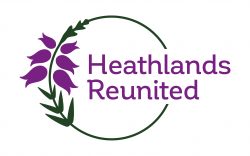 Our Heathlands Reunited project is working to bring back grazing to help restore, recreate and reconnect the remaining 1% of our fragmented heathland habitats across the National Park. The project aims to reintroduce conservation grazing on 300ha of heathland across five sites.
Our Heathlands Reunited project is working to bring back grazing to help restore, recreate and reconnect the remaining 1% of our fragmented heathland habitats across the National Park. The project aims to reintroduce conservation grazing on 300ha of heathland across five sites.
So far the project has contributed toward the funding of the fencing at Iping common which has allowed Sussex Wildlife Trust to extend their grazing of British Whites. We are also working with the Lynchmere Society to establish their community ‘Cow Club’ which supports the grazing of Belted Galloways at Lynchmere Common.
This year we will see the re-fencing of the MOD land at Woolmer Forest and the introduction of Longhorn cattle across 220ha, adding to Hampshire & Isle of White Wildlife Trust’s British Whites and Shetland cattle that are grazing at Longmoor. The project is also working with the National Trust to help progress their plans to introduce conservation grazing on Ludshott common.

